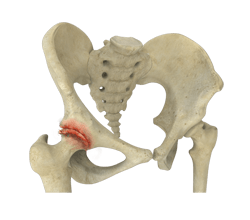
What is Osteoarthritis of the Hip?
Osteoarthritis, also called degenerative joint disease, is the most common form of arthritis. It occurs most often in the elderly. This disease affects the tissue covering the ends of bones in a joint called cartilage. In osteoarthritis, the cartilage becomes damaged and worn out, causing pain, swelling, stiffness and restricted movement in the affected joint. Although osteoarthritis may affect various joints including the hips, knees, hands, and spine, the hip joint is most commonly affected.
Causes of Osteoarthritis of the Hip
Advanced age is one of the most common reasons for osteoarthritis of the hip. You may also develop osteoarthritis in the following cases:
- Previous hip injury or fracture
- Family history of osteoarthritis
- Suffer from hip diseases such as avascular necrosis and other congenital or developmental hip diseases
Symptoms of Osteoarthritis of the Hip
You will experience pain in the hip and thighs, morning stiffness and limited range of motion. Typically the pain is located in the front of the hip but on occasion can be on the side or back of the hip.
Diagnosis of Osteoarthritis of the Hip
Based on your symptoms, Dr. McNabb will perform a physical examination, and typically evaluate the joint with an x-ray.
Management of Osteoarthritis of the Hip
There are several treatments and lifestyle modifications that can help you ease your pain and symptoms.
- Medications: Anti-inflammatories (NSAIDs such as ibuprofen or naproxen) can be taken orally. Topical medications such as ointments can be applied over the skin to relieve pain. If the pain is very severe, a corticosteroid injection can be administered directly into the affected joint to ease the pain.
- Other treatments: You may benefit from physical therapy where exercises and be utilized to keep your joints flexible and improve muscle strength. Heat/cold therapy that involves applying heat or cold packs to the joints provides temporary pain relief. Lifestyle modifications are encouraged to control your weight and avoid extra stress on the weight-bearing joints.
- Surgery: Hip joint replacement surgery is considered as an option when the pain is so severe that it affects your ability to carry out normal activities and you have failed non-operative management.






